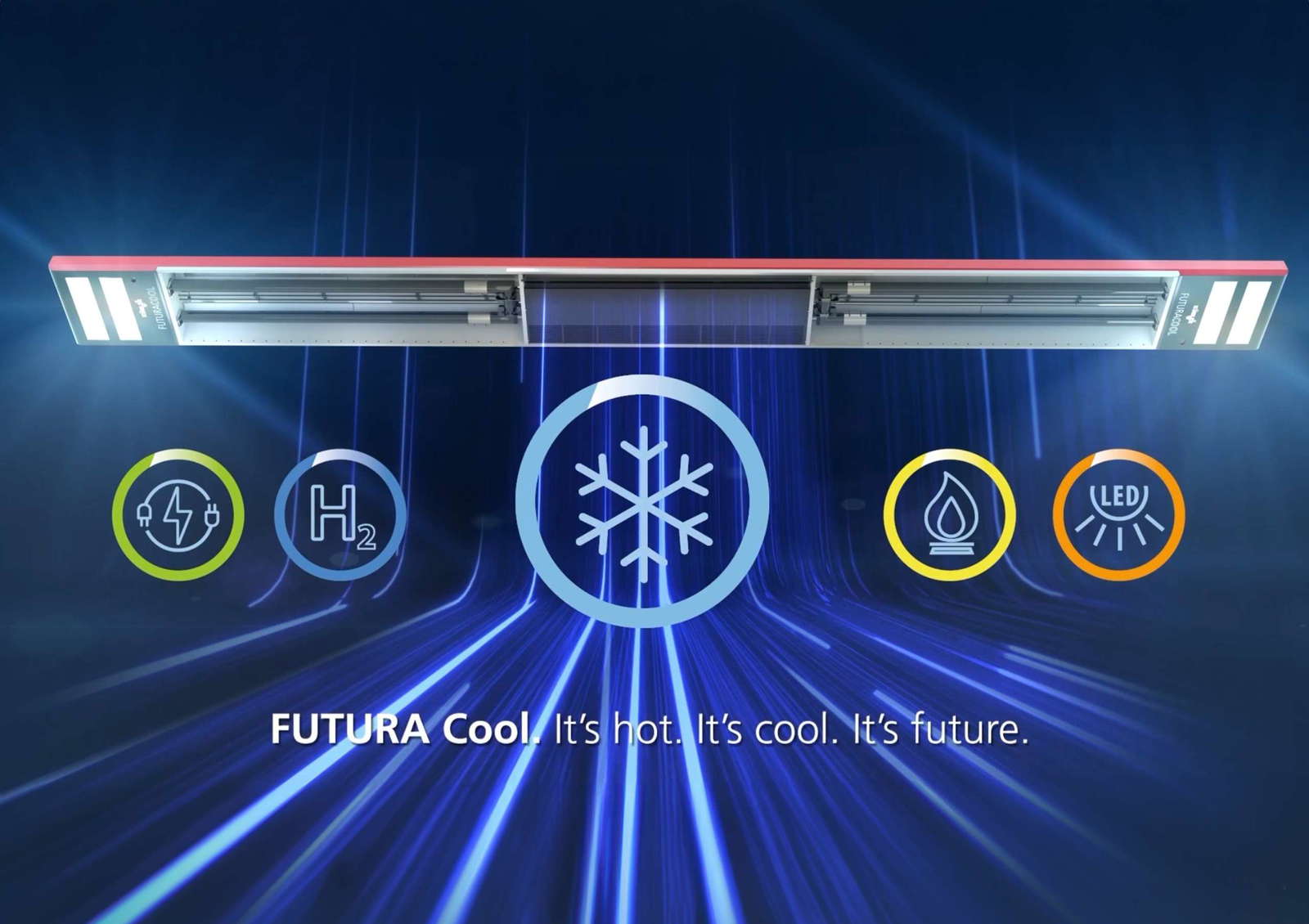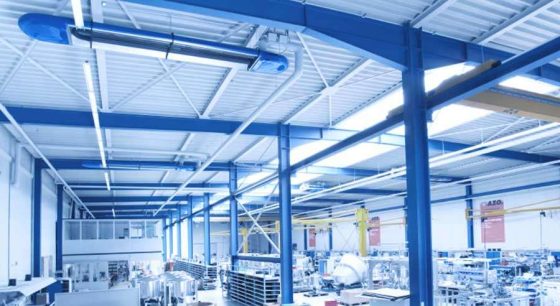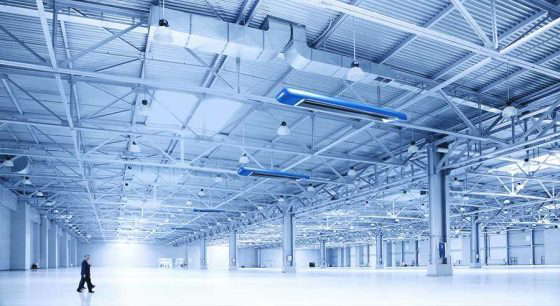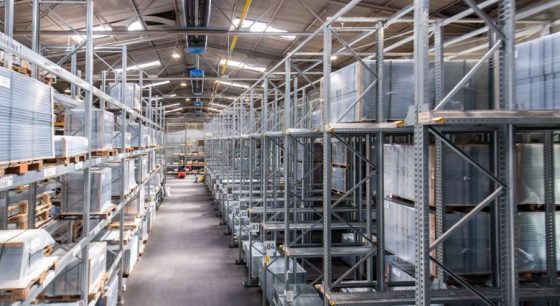Heating halls: 6 heating systems at a glance

Getting started - the difference between centralized and decentralized systems
Systems for heating halls are divided into centralized and decentralized systems. Centralized systems require a separate boiler room in which heat is generated. This heat is then conducted to the heaters, where it heats the heating medium inside, which in turn provides heat for heating. This process is also known as "indirect heating". However, some of the heat is already lost during transportation.
Decentralized systems, on the other hand, use the primary energy directly in the usable space or the heater itself, which only generates the heat where the employees need it. They do not require a separate boiler room and can be used more flexibly and quickly.
Hot air heating for halls: You have these options
The basic principle behind warm air heating systems is very simple and quickly explained: a fan directs warm air into a room and heats it in this way. If you want to use warm air to heat halls, you have two options:
Decentralized heat supply via hot air generator
With direct-fired hot air heaters, the burner generates the heat directly in a decentralized manner. Air drawn in on the secondary side is then heated by means of a heat exchanger and blown into the hall.
When heating halls with the help of warm air heaters, it is possible to use room air-dependent and room air-independent operating modes. This means that the appliance either draws in fresh air or heats the air from the hall itself. The latter is particularly practical. As warm air is known to rise upwards, the air in the working or floor area tends to be colder. Room air-dependent warm air heaters feed precisely this cool air back into the warm air generator and thus ensure that it is replenished. Room air-independent appliances, on the other hand, often also use the heat from the flue gas duct to heat the air supplied from outside.
Central heating of halls with an air heater
Indirectly heated air heaters, also known as air heaters, do not heat the air themselves. Instead, a separate boiler or central heating system is connected here, which heats the heat exchanger externally. The air heater also draws in air and then passes it through the heat exchanger, which heats it. The warm air can then be blown into the hall or distributed via air ducts. If you want to use an air heater to heat halls, you should again consider convection and plan for warm air recirculation or ceiling fans accordingly.
Panel heating systems for heating halls
You can install panel heating in the floor, ceiling or walls. Underfloor heating is probably the most widespread, but the system behind it is basically the same. For underfloor heating, thin pipes are laid across the entire surface of the floor in a serpentine pattern during the construction of the hall. Underfloor heating can also be retrofitted in an additional layer of screed.
To heat halls, an externally heated heating medium (e.g. water) is fed through these pipes. The heat generated in this way can be felt directly in the floor and is only slowly released into the room, but remains there for a while even if the heating is switched off briefly.
With this heating system, please note that anchoring shelves or machines too low can damage the heating hoses.
Not to be forgotten: The radiant heaters
When heating halls via radiant heat, a distinction is made between light and dark radiators. There are also radiant ceiling panels.
Radiant ceiling panels
Also known as a "hot water radiant ceiling panel", this system involves pipes being welded onto a metal plate directly under the ceiling. Similar to underfloor heating, hot water heated by an external heat generator flows through these pipes, transferring the heat to the entire structure. A radiant panel then directs the heat downwards into the room, where it raises the surface temperatures of all surfaces.
You should install an insulating layer between the ceiling and the radiant ceiling panel to reduce heat loss upwards. If you want to use radiant ceiling panels to heat halls, you should also plan for a large heating surface of approx. 15-20 % of the ceiling area.
Dark radiators for efficient heating of halls
Dark radiatoralso known as black radiant heaters, are a variant of infrared radiant heating. Halls are heated decentrally by individual appliance units that generate a long flame in a radiant tube using a burner. The energy source is usually natural or liquid gas, but biogas and hydrogen also have potential for the future.
Reflectors on the radiant tube direct the heat generated in the form of infrared radiation into the areas to be heated. There, this only provides heat when it hits the room frame and surfaces of objects or people - similar to the sun. The decisive advantage of radiant heating systems of this type is therefore that, for physical reasons, no warm air rises below the ceiling and has to be returned.
Bright radiators: heat generation via ceramic
Bright spotlight work in a similar way to dark radiators. A gas-air mixture is burned on ceramic plates, generating heat and emitting infrared radiation. Reflectors direct the rays into the working area. However, the fundamental difference lies in the combustion process. In bright radiators, this takes place openly - and so the exhaust gases initially remain in the room. Indirect removal of the exhaust gases is therefore necessary. Anyone relying on radiant heating systems for heating halls must therefore ensure adequate ventilation.
What is particularly worthwhile for heating halls?
Which heating system is the right choice for you depends entirely on your usage profile and your economic requirements. For room heights of 4 meters or more, however, infrared dark radiators are recommended here, as they are particularly well designed for the physical characteristics of halls and are characterized by comparatively low investment costs with high efficiency, flexibility and operational reliability. Let's talk about this in a personal meeting - or find out more with our Configurator to find out which heating system is best suited to your property!
-
Heating industrial and event halls economically and flexibly: radiant heaters are ideally suited for this job. An overview of how they work, types and possible applications.
-
If you are reading this article, you are probably looking for an efficient way to heat your industrial or commercial building. During your research, you have already come across one or other technology such as dark radiant heaters or hot air. Now you want to know why dark radiant heaters in particular are repeatedly highlighted as especially efficient. We'll tell you!
-
ESG stands for Environmental, Social and Corporate Governance and refers to the three key areas of sustainable corporate management: environment, social affairs and corporate governance. But what does this have to do with you and the way you heat your production halls and warehouses?
-
The energy crisis is currently leaving no one indifferent. Everyone is desperately looking for ways to get consumption and costs under control to some extent. The German government's price brake will not take effect until March 2023, and even then, the prices for 30 percent above the basic quota for industry and 20 percent for small and medium-sized enterprises will still be subject to the wild market conditions next year. So what to do?







